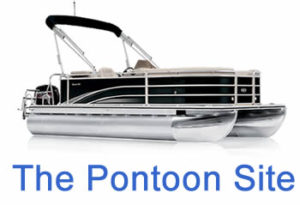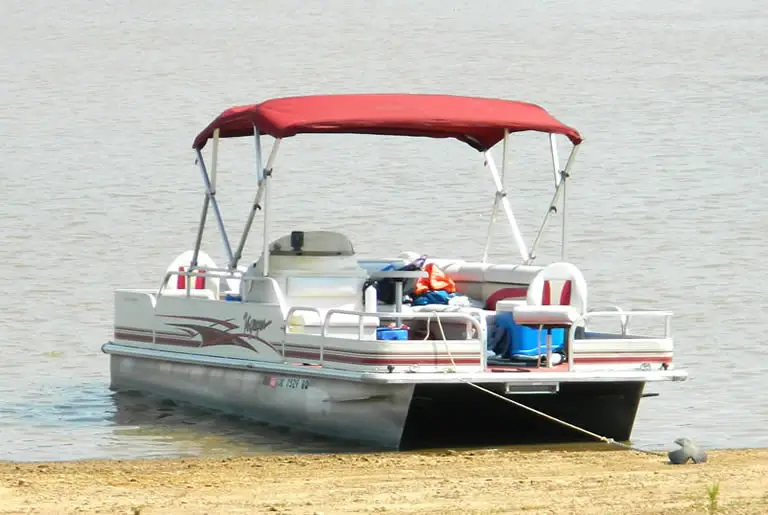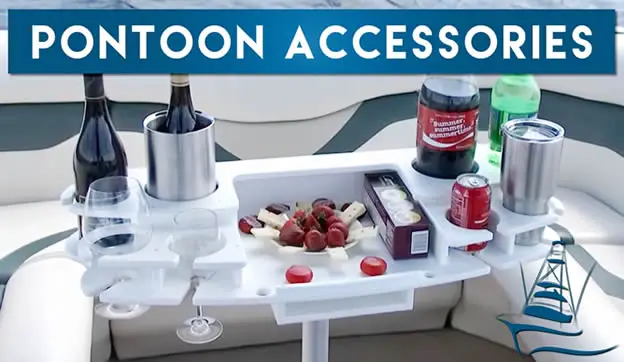The pontoon boat is renowned the world over as a great shallow water recreational boat. Whether it’s pulling tubes or water skiers at speed across still water or simply cruising slowly on a lake these boats offer a lot of fun on the water. However, not all pontoon boat activities involve moving.
Sometimes you will want the boat to stay in one spot and this means setting the anchor to hold the boat in place. But what size anchor do you need for your specific pontoon boat?
The size of anchor you need for your specific pontoon boat will depend on the holding power that is required. Anchor sizes are not chosen based on the size of the boat but on the holding power required and the holding ability of the anchor.
Holding power is affected by conditions such as wind, current and the type of bottom the anchor will be set in. However, you can easily gauge the anchor size and anchor rode length you need using our tables below.
Contents
It’s not just about size: how to pick the correct pontoon boat anchor system
Pontoon boats are fairly versatile inland waterway vessels. They can be used for a multitude of activities from tubing to water skiing and fishing. A pontoon boat can go pretty fast and is also a joy to cruise on. But sometimes you will want to set the anchor so your boat stays in one place.
So how do you know what size of anchor you need for your boat?
I have already covered the different types of anchors you need for specific bottoms and you will need to read that article before you make a final decision on the anchor you want for your pontoon boat, However, you will also need to decide on the size of anchor you need. While the type of anchor you choice will depend on the the marine environment you are boating in, it is the holding power of the anchor that determines what size of anchor you need.
Before making a decision on a pontoon anchor you will need to consider:
- The anchor’s holding power.
- The anchor type.
- The anchor’s weight.
- The length of rode you need for the anchor.
Let’s look at these four points a little bit closer to see how they will affect your choice of anchor size.
The anchor’s holding power matters
It might seem counter-intuitive when you learn that the size and weight of your boat is not the main factor in determining the size of anchor your boat needs but, it is true nonetheless.
Anchors are rated by their holding power power more than on their size and weight. A bigger anchor will not necessarily hold a boat better than a much smaller anchor for reasons I will cover later.
To understand why holding power is important we need to look at what “holding power” actually means when it comes to a boat anchor.
Holding power refers to an anchor’s ability to keep the boat held firmly in place even when environmental factors are affecting its holding ability. Wind and water current are the main environmental factors that affect an anchor’s holding power.
Holding power is measured in lbs. So rather than looking at the size or weight of the anchor you look at its holding power to determine if it has enough to be beneficial for your pontoon boat.
The rule-of-thumb is that an anchor that has a holding power of 90 lbs can hold a 20 foot boat in up to 20 mph winds.
When the boat length increases the holding power of the anchor must also be increased. So, for a 25 foot boot, in 20 mph winds, an anchor with 125 lbs of holding power would be needed.
Obviously if you boat in winds higher than 20 mph you will need an anchor with greater holding power (though there is a work-around for this that I’ll cover in the anchor weight section).
As pontoon boats are rarely used in windy conditions it will be unlikely that you need to factor in wind into your anchor choice.
Anchor type is important
Wind and water current are not the only environmental factors at play when it comes to the holding power of an anchor. The bottom of the body of water you are anchoring in has an effect on an anchor’s holding power.
Water bodies such as lakes and ponds can have a range of different bottoms from rocky and gravel-like bottoms to bottoms with thick mud or fine sand. This is why there are different types of anchors that are designed to have maximum holding power in different types of bottoms.
For example, a grapnel anchor is a perfect choice for firm bottoms and shallow water but may struggle to hold your boat in mud or sand bottoms regardless of its size. Whereas a box anchor will give much better hold in sand and mud even if it is much smaller than the grapnel anchor.
I have previously covered this subject in-depth and you should therefore read our helpful guide to choosing the correct pontoon boat anchor after you have finished reading this article and understand how to choose the correct sized anchor. When you have the correct anchor type, and correct anchor size, your pontoon boat will be unmovable on the water.
The anchor’s weight is not as important
Many manufacturers and retailers will often market their anchors based on the anchors weight. However, this is slightly misleading for new boaters. The weight of the anchor is much less important than its holding power.
Having said that though, although the weight of the anchor is less important than the anchor’s holding power anchor weight is still something you should consider but for a different reason.
If you regularly boat in areas where you don’t need a lot of holding power, having a spare anchor that is heavier is an advantage. Why? Because having a heavier anchor will help you to offset any unusual blasts of wind and deal with any unexpected windy weather that appears while out on the water.
Although the heavier anchor will not be a good choice for a working anchor it is good to have onboard in case of emergencies with the wind. It could be just enough to hold your boat in place until the danger passes.
I keep two anchors onboard any boat I am on, making sure one anchor is much heavier than the other just in case I need it in emergency situations or if the wind picks up unexpectedly. As I mentioned earlier I also ensure each anchor is a different type so I can deal with different environments better.
Many pontoon boat owners will keep a second heavier mushroom anchor for added weight when they need it and an anchor better suited to the bottom of the lake they are boating on.
The anchor rode is an important part of the pontoon boat anchor system
Ensuring your boat has the correct anchor system isn’t just about picking the correct sized anchor. You also need to take into consideration the length of rode you need.
The rode refers to the the line that is attached to the anchor and it can be made of chain or nylon, though the best option is to mix the two.
The rule-of-thumb is to make the length of anchor rode between five to seven times longer than the depth of the water you are anchoring in.
Boat anchor size and rode guide
Below are some tables to help you choose the correct sized anchor for your pontoon boat.
The first table refers to the weight of the anchor you need (based on its holding power) and is based on the weight of your boat.
Just bear in mind that knowing the type of marine environment you will regularly boat in will go a long way in helping you choose the correct anchor size and type. If you take your pontoon boat into areas with strong wind or strong current then you will obviously need an anchor with more holding power than if you boat only in still water.
As I already mentioned I always keep 2 anchors onboard any larger boat that I am in (pontoon boats and other types) and I make sure each is a different anchor type with a different weight just in case I need to change the anchor or double anchor the boat.
Boat anchor size chart guide
Please take into consideration everything I have said in this article and do not just solely rely on the table below to make a decision.
Wind and current, as well as the type of bottom you are anchoring in, are all very important factors that should influence your choice of anchor size!
Pontoon Anchor Size Chart
| PONTOON BOAT | ANCHOR TYPE (weight needed) | |||||||
|---|---|---|---|---|---|---|---|---|
| Length (ft.) | Weight (lbs) | Bruce (lbs) | Danforth (lbs) | Fluke(lbs) | Plow (lbs) | Luke (lbs) | ||
| 20 – 25 | 2,500 | 4.4 | 8S, 5-H | 4 | 10 | 15 | ||
| 25 – 30 | 5,000 | 11 | 13-S, 12-H | 7 | 15 | 25 | ||
| 30 – 35 | 10,000 | 11 – 16.5 | 22-S, 12-H | 7 – 10 | 20 | 35 – 40 | ||
| 35 – 40 | 15,000 | 16.5 | 22-S, 20-H | 10 | 25 | 50 | ||
Anchor rode size chart guide
Below is a quick-view chart for picking the correct sized anchor for your specific pontoon boat.
Remember, it’s not just about the size of the anchor and the length of the line; you must also ensure you are using the correct type of anchor for the water bottom your boat is anchoring in!
Pontoon Rode Size & Length Chart
| BOAT SIZE | ANCHOR RODE | |||||||
|---|---|---|---|---|---|---|---|---|
| Length (ft.) | Weight (lbs) | Chain (dia.-inch) | Nylon (dia.-inch) | Length (ft.) | ||||
| 20 – 25 | 2,500 | 3/16 | 7/16 | 90 | ||||
| 25 – 30 | 5,000 | 1/4 | 7/16 | 135 | ||||
| 30 – 35 | 10,000 | 5/16 | 1/2 | 190 | ||||
| 35 – 40 | 15,000 | 3/8 | 9/16 | 225 | ||||
Anchoring a pontoon boat
Now that you are better informed about how to pick the right anchor type and the right anchor size for you boat you need to learn how to anchor a pontoon boat correctly. If you are unsure which anchor type you need for your pontoon boat, and need more information on the correct rode type for a pontoon boat, be sure to read the article on that here.
You may also be interested in the article that covers where you should dock or anchor a pontoon boat. And may want to check out our 55 best pontoon boat accessories.



